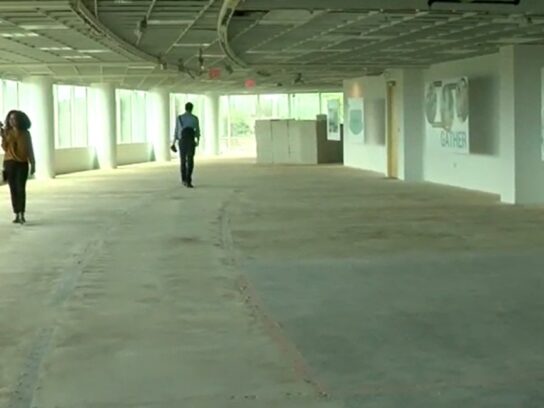
On Tuesday, Montgomery County Council adopted innovations they hope will create more housing. Their actions both incentivize and speed up the process of converting vacant office buildings into housing.
During the first quarter of 2025, there was a 19% office vacancy rate in the county. Officials called an 8 to 10% office vacancy rate “healthy.”
“We have a lot of vacant, underused” buildings, said Council President Kate Stewart. The council wants to repurpose “these ghost buildings,” she said.
Many councilmembers said the need to create more housing is even more necessary now when there may be a recession in the near future. Other considerations include the possibility of federal office buildings in the county being shuttered and the impact of the administration’s tariff policy on local businesses.
“As government, we must use every tool possible to build more housing. That responsibility certainly includes zoning reform and incentivizing half-vacant office buildings to create homes for people to thrive,” stated Council member Natali Fani-González, chair of the Economic Development Committee.
“We are dealing with a housing crisis,” she said. “Vacant commercial buildings help no one.”
“Our county’s lack of housing supply and excess office vacancies are a scourge on our communities and a drain on our local economy,” Planning, Housing, and Parks Committee Chair Councilmember Andrew Friedson said. “Transforming vacant buildings into housing is a win for our residents and our businesses, and a strategic investment that will ultimately yield more housing, more revenue, and more opportunities to live and work in Montgomery County.”
The county receives little income from vacant buildings. The assessed value of office real estate is 6% of total assessed value in the county. At the same time vacancy rates are high, housing prices are rising. According to the county, the median sales price of homes here increased by more than 11%. Wages increased only by 1.7%.
A move to create a commercial to residential reconstruction use for commercial buildings at least 50% vacant to be converted or razed and changed to a residential building was approved. Buildings must be used mainly for offices and more than two stories.
The zoning text amendment creates an expedited approval process to rapidly create housing.
Another zoning amendment would allow self-storage in buildings that have been 90% vacant for at least two years if a community-serving use is permitted on the ground floor. Currently, self-storage is only allowed here in the basement. This amendment is called SAVE – Street Activation and Vacancy Elimination.
Council Vice President Will Jawando cast the lone negative vote concerning an amendment to offer a financial incentive for a residential development resulting from the conversion of a property designated for commercial use with at least a 50% vacancy rate. The new residential building must make at least 17.5% of its units affordable to tenants earning 60% or less of the area’s median income.
It would exempt 100% of the real property tax that would otherwise be levied for at least 20 years. In earlier reports, Jawando estimated that cost to the county at more than 2.5 billion dollars.
“This is not just for conversion. It’s for the demolition. You could just knock it down and get this tax abatement,” he pointed out.
These measures are part of the More Housing N.O.W. (New Options for Workers) package spearheaded by Friedson and Fani-González. The goal is increased supply of housing, reduced costs and expanded homeownership opportunities.
More housing types, including small apartment complexes and condos, in certain residential areas form part of the plan. This idea is currently under review. It also sets aside a Workforce Housing Opportunity Fund in the proposed Fiscal Year 2026 budget.

